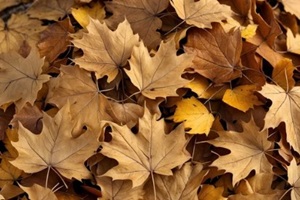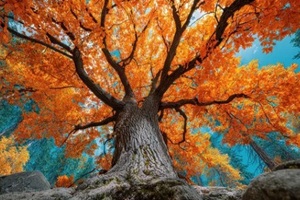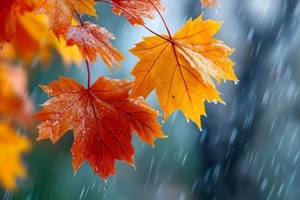
Virginia’s fall season is marked by natural beauty and is enjoyed by property owners, visitors, and tree lovers everywhere. Taking a closer look at this fall foliage reveals not only the trees that are the most captivating to visitors but also those that are most valuable to property owners.
Recognizing the tree species responsible for Virginia’s most popular foliage can help property owners and enthusiasts alike admire and preserve their surroundings for years to come.
This article shines a spotlight on the trees that make Virginia a premier fall destination, as well as how elevation and weather impact the timing of this beautiful foliage.
Why is Fall Longer in Virginia?
Though the fall season is not technically longer, the fall colors seem to last longer in Virginia due to its distinct topography. On the West, high elevations begin the seasonal color change; to the East, the coastal shores are the last to turn. Since the timing of the season is staggered, trees in Virginia keep their iconic fall palette for longer than other states. The coast may still be in peak fall foliage as late as early November, even as Northern VA is already transitioning to winter.
Virginia is so spoiled for autumn color choices that property owners can even prioritize the colors (red, yellow, or orange) that they like most when planning their landscapes. They just have to know which trees will deliver the colors and impact they hope to achieve.
Virginia’s Red Foliage: Red Maple and Sourwood
Red maple trees line the scenic landscapes of Virginia with splashes of deep red, contrasting with the yellows and oranges of other tree varieties. Yet, debatably, none is brighter than Virginia’s native sourwoods, which often speckle the ridgelines of the Appalachian Mountains and the southern regions with crimson reds.
For a late-fall surprise, the humble oak can turn amber and deep burgundy red after all the other trees have gone through their cycle, leaving a lasting impression of autumn as everyone heads into November and prepares for winter.
Virginia’s Yellow Foliage: Birch, Hickory, and Walnut

Across Virginia, birch, hickory, and walnut trees provide a rich yellow backdrop that complements the surrounding fall transformations, starting in mid to late October in the west and stretching to early November in the east.
According to the Virginia Department of Forestry, areas impacted by summer droughts can experience even earlier yellowing, leading to surprisingly green fall seasons as the leaves drop early. Beeches and tulip-poplars may also show as yellow, but none compare to the lively golds of hickory trees, which are a staple of the mid-fall landscapes in the southwest.
Virginia’s Orange Foliage: Sugar Maple, Beech, Dogwood
These beautiful trees can deliver lively amber and orange tones in the middle of the Virginia fall. Sugar maples are some of the most colorful trees of the season, turning the Southwest Virginia mountainsides into a patchwork quilt of ochre and gold.
Many of Virginia’s shrub species also contribute to this gorgeous transformation, as plants like sumac and sassafras provide complimentary orange hues, while the iconic Virginia creeper vines turn crimson red. Many property owners line their fences with them to create dazzling streaks of fall color at multiple levels of their landscape.
Dogwoods, Virginia’s state tree, live up to their status and show out in vibrant shades of orange, red, or purple depending on the variety.
How to Time Fall Colors in Virginia
With so many overlapping transformations, Virginia property owners often wonder how they can time their landscapes to produce the colors they desire. Elevation and weather play a key role in fall color timing.
High-elevation areas like the Blue Ridge Mountains typically peak around mid-October, while lower-elevation regions, including most of Northern Virginia, reach their most vibrant hues a few weeks later, in the last week of October or the first week of November.
As mentioned, droughts can bring out yellow coloring or even force the foliage to fall early. However, sunny days and cool nights can do the same for red leaves. The trick to creating an iconic Virginia landscape on any property is to mix tree species with different timings and create the kind of seasonal color pallettes seen in natural mixed wood forests.
Combinations of red maple, dogwood, beech, sweetgum, and birch can produce evolving displays that last the entire fall season. For upland landscapes, focusing on trees with red colors is usually preferred while lower and mixed border properties should focus on yellow.
Team Up With An Arborist to Help Your Trees Thrive and Show Off Their Best Displays of Fall Foliage.

In the summertime, Virginia’s property owners and sightseers have the benefit of its abundant forests, which stay lush and green all season long. In fall, these deciduous trees, both native and foreign, transition in staggered waves from the mountains to the coast in a cloak of red, yellow, and orange.
Property owners can strategize the visual appeal of their land by planting a mix of trees that will transition at different times, producing the iconic fall foliage that draws people to Virginia each year.
Contact our team of arborists at RTEC Treecare to learn more about your landscape, take advantage of the most popular fall foliage in Virginia, and maintain your property’s value with a preservation-focused approach to Plant Health Care.


